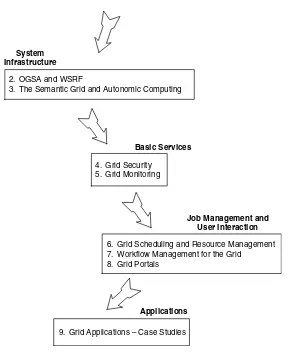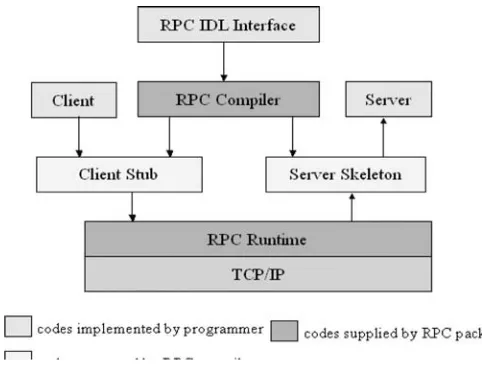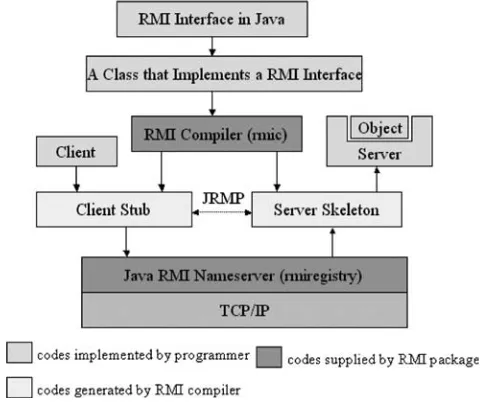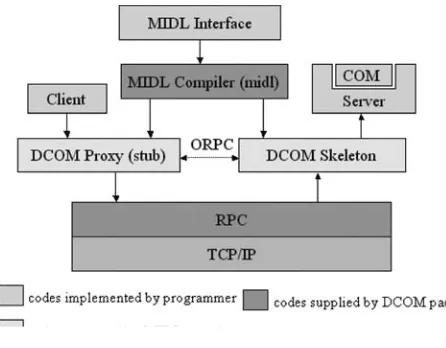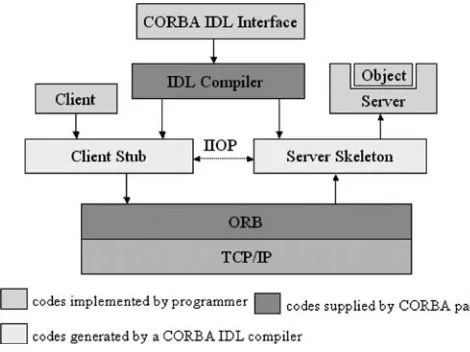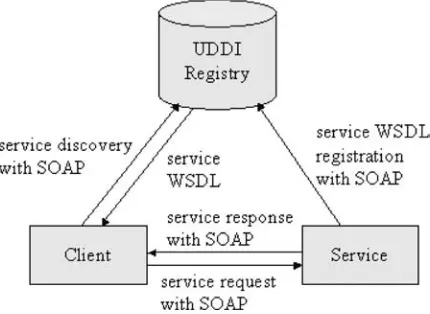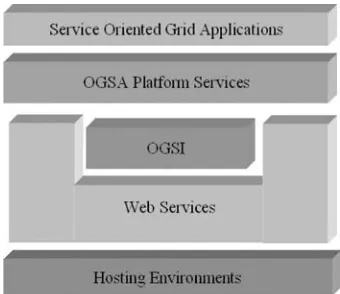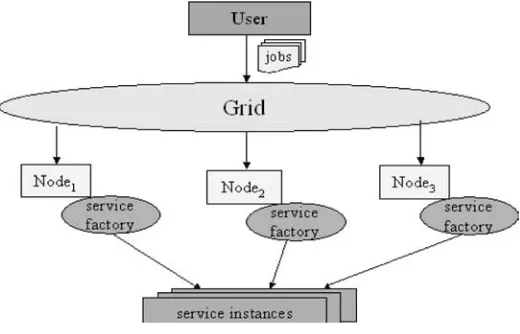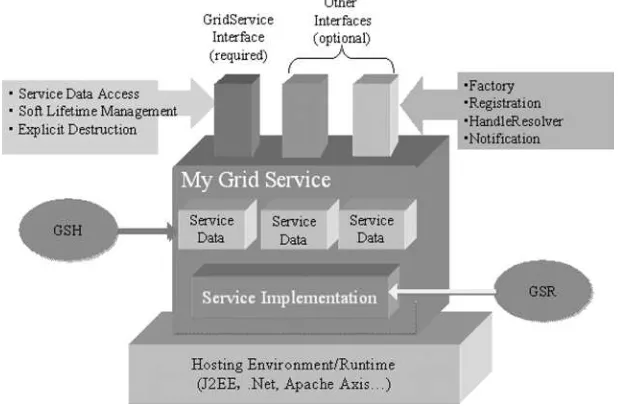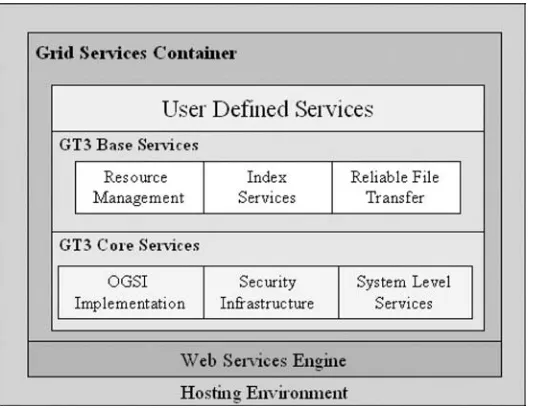The Grid
Core Technologies
Maozhen Li
Brunel University, UK
Mark Baker
Telephone (+44) 1243 779777
Email (for orders and customer service enquiries): cs-books@wiley.co.uk Visit our Home Page on www.wiley.com
All Rights Reserved. No part of this publication may be reproduced, stored in a retrieval system or transmitted in any form or by any means, electronic, mechanical, photocopying, recording, scanning or otherwise, except under the terms of the Copyright, Designs and Patents Act 1988 or under the terms of a licence issued by the Copyright Licensing Agency Ltd, 90 Tottenham Court Road, London W1T 4LP, UK, without the permission in writing of the Publisher. Requests to the Publisher should be addressed to the Permissions Department, John Wiley & Sons Ltd, The Atrium, Southern Gate, Chichester, West Sussex PO19 8SQ, England, or emailed to permreq@wiley.co.uk, or faxed to+441243 770620. Designations used by companies to distinguish their products are often claimed as trademarks. All brand names and product names used in this book are trade names, service marks, trademarks or registered trademarks of their respective owners. The Publisher is not associated with any product or vendor mentioned in this book.
This publication is designed to provide accurate and authoritative information in regard to the subject matter covered. It is sold on the understanding that the Publisher is not engaged in rendering professional services. If professional advice or other expert assistance is required, the services of a competent professional should be sought.
Other Wiley Editorial Offices
John Wiley & Sons Inc., 111 River Street, Hoboken, NJ 07030, USA
Jossey-Bass, 989 Market Street, San Francisco, CA 94103-1741, USA
Wiley-VCH Verlag GmbH, Boschstr. 12, D-69469 Weinheim, Germany
John Wiley & Sons Australia Ltd, 33 Park Road, Milton, Queensland 4064, Australia
John Wiley & Sons (Asia) Pte Ltd, 2 Clementi Loop #02-01, Jin Xing Distripark, Singapore 129809
John Wiley & Sons Canada Ltd, 22 Worcester Road, Etobicoke, Ontario, Canada M9W 1L1
Wiley also publishes its books in a variety of electronic formats. Some content that appears in print may not be available in electronic books.
Library of Congress Cataloging in Publication Data Li, Maozhen.
Core technologies / Maozhen Li, Mark Baker. p. cm.
ISBN-13 978-0-470-09417-4 (PB) ISBN-10 0-470-09417-6 (PB)
1. Computational grids (Computer systems) 2. Electronic data processing—Distributed processing. I. Baker, Mark. II. Title.
QA76.9.C58L5 2005 005.3′6—dc22
2005002378
British Library Cataloguing in Publication Data
A catalogue record for this book is available from the British Library
ISBN-13 978-0-470-09417-4 (PB) ISBN-10 0-470-09417-6 (PB)
Typeset in 11/13pt Palatino by Integra Software Services Pvt. Ltd, Pondicherry, India Printed and bound in Great Britain by Antony Rowe Ltd, Chippenham, Wiltshire
Contents
About the Authors xiii
Preface xv
Acknowledgements xix
List of Abbreviations xxi
1 An Introduction to the Grid 1
1.1 Introduction 1
1.2 Characterization of the Grid 1
1.3 Grid-Related Standards Bodies 4
1.4 The Architecture of the Grid 5
1.5 References 6
Part One System Infrastructure 9
2 OGSA and WSRF 11
Learning Objectives 11
Chapter Outline 11
2.1 Introduction 12
2.2 Traditional Paradigms for Distributed Computing 13
2.2.1 Socket programming 14
2.2.2 RPC 15
2.2.3 Java RMI 16
2.2.4 DCOM 18
2.2.5 CORBA 19
2.2.6 A summary on Java RMI, DCOM and CORBA 20
2.3 Web Services 21
2.3.1 SOAP 23
2.3.2 WSDL 24
2.3.3 UDDI 26
2.3.4 WS-Inspection 27
2.3.5 WS-Inspection and UDDI 28
2.3.6 Web services implementations 29
2.4 OGSA 34
2.4.1 Service instance semantics 35
2.4.2 Service data semantics 37
2.4.3 OGSA portTypes 38
2.4.4 A further discussion on OGSA 40
2.5 The Globus Toolkit 3 (GT3) 40
2.5.1 Host environment 41
2.5.2 Web services engine 42
2.5.3 Grid services container 42
2.5.4 GT3 core services 43
2.5.5 GT3 base services 44
2.5.6 The GT3 programming model 50
2.6 OGSA-DAI 53
2.6.1 OGSA-DAI portTypes 54
2.6.2 OGSA-DAI functionality 56
2.6.3 Services interaction in the OGSA-DAI 58
2.6.4 OGSA-DAI and DAIS 59
2.7 WSRF 60
2.7.1 An introduction to WSRF 60
2.7.2 WSRF and OGSI/GT3 66
2.7.3 WSRF and OGSA 69
2.7.4 A summary of WSRF 70
2.8 Chapter Summary 70
2.9 Further Reading and Testing 72
2.10 Key Points 72
2.11 References 73
3 The Semantic Grid and Autonomic Computing 77
Learning Outcomes 77
Chapter Outline 77
3.1 Introduction 78
3.2 Metadata and Ontology in the Semantic Web 79
3.2.1 RDF 81
3.2.2 Ontology languages 83
3.2.3 Ontology editors 87
3.2.4 A summary of Web ontology languages 88
3.3 Semantic Web Services 88
3.3.1 DAML-S 89
3.3.2 OWL-S 90
3.4 A Layered Structure of the Semantic Grid 91
3.5 Semantic Grid Activities 92
3.5.1 Ontology-based Grid resource matching 93 3.5.2 Semantic workflow registration and discovery in myGrid 94 3.5.3 Semantic workflow enactment in Geodise 95 3.5.4 Semantic service annotation and adaptation in ICENI 98 3.5.5 PortalLab – A Semantic Grid portal toolkit 99
3.5.6 Data provenance on the Grid 106
CONTENTS vii
3.6 Autonomic Computing 108
3.6.1 What is autonomic computing? 108
3.6.2 Features of autonomic computing systems 109
3.6.3 Autonomic computing projects 110
3.6.4 A vision of autonomic Grid services 113
3.7 Chapter Summary 114
3.8 Further Reading and Testing 115
3.9 Key Points 116
3.10 References 116
Part Two Basic Services 121
4 Grid Security 123
4.1 Introduction 123
4.2 A Brief Security Primer 124
4.3 Cryptography 127
4.3.1 Introduction 127
4.3.2 Symmetric cryptosystems 128
4.3.3 Asymmetric cryptosystems 129
4.3.4 Digital signatures 130
4.3.5 Public-key certificate 130
4.3.6 Certification Authority (CA) 132
4.3.7 Firewalls 133
4.4 Grid Security 134
4.4.1 The Grid Security Infrastructure (GSI) 134
4.4.2 Authorization modes in GSI 136
4.5 Putting it all Together 140
4.5.1 Getting an e-Science certificate 140
4.5.2 Managing credentials in Globus 146
4.5.3 Generate a client proxy 148
4.5.4 Firewall traversal 148
4.6 Possible Vulnerabilities 149
4.6.1 Authentication 149
4.6.2 Proxies 149
4.6.3 Authorization 150
4.7 Summary 151
4.8 Acknowledgements 151
4.9 Further Reading 151
4.10 References 152
5 Grid Monitoring 153
5.1 Introduction 153
5.2 Grid Monitoring Architecture (GMA) 154
5.2.1 Consumer 155
5.2.2 The Directory Service 156
5.2.3 Producers 157
5.3 Review Criteria 161
5.3.1 Scalable wide-area monitoring 161
5.3.2 Resource monitoring 161
5.3.3 Cross-API monitoring 161
5.3.4 Homogeneous data presentation 162
5.3.5 Information searching 162
5.3.6 Run-time extensibility 162
5.3.7 Filtering/fusing of data 163
5.3.8 Open and standard protocols 163
5.3.9 Security 163
5.3.10 Software availability and dependencies 163 5.3.11 Projects that are active and supported;
plus licensing 163
5.4 An Overview of Grid Monitoring Systems 164
5.4.1 Autopilot 164
5.4.2 Control and Observation in Distributed
Environments (CODE) 168
5.4.3 GridICE 172
5.4.4 Grid Portals Information Repository (GPIR) 176
5.4.5 GridRM 180
5.4.6 Hawkeye 185
5.4.7 Java Agents for Monitoring and Management (JAMM) 189
5.4.8 MapCenter 192
5.4.9 Monitoring and Discovery Service (MDS3) 196
5.4.10 Mercury 201
5.4.11 Network Weather Service 205
5.4.12 The Relational Grid Monitoring
Architecture (R-GMA) 209
5.4.13 visPerf 214
5.5 Other Monitoring Systems 217
5.5.1 Ganglia 217
5.6.1 Resource categories 225
5.6.2 Native agents 225
5.6.3 Architecture 226
5.6.4 Interoperability 226
5.6.5 Homogeneous data presentation 226
5.6.6 Intrusiveness of monitoring 227
5.6.7 Information searching and retrieval 231
5.7 Chapter Summary 233
5.8 Further Reading and Testing 236
5.9 Key Points 236
CONTENTS ix
Part Three Job Management and User Interaction 241
6 Grid Scheduling and Resource Management 243
Learning Objectives 243
Chapter Outline 243
6.1 Introduction 244
6.2 Scheduling Paradigms 245
6.2.1 Centralized scheduling 245
6.2.2 Distributed scheduling 246
6.2.3 Hierarchical scheduling 248
6.3 How Scheduling Works 248
6.3.1 Resource discovery 248
6.3.2 Resource selection 251
6.3.3 Schedule generation 251
6.3.4 Job execution 254
6.4 A Review of Condor, SGE, PBS and LSF 254
6.4.1 Condor 254
6.4.2 Sun Grid Engine 269
6.4.3 The Portable Batch System (PBS) 274
6.4.4 LSF 279
6.4.5 A comparison of Condor, SGE, PBS and LSF 288
6.5 Grid Scheduling with QoS 290
6.5.1 AppLeS 291
6.5.2 Scheduling in GrADS 293
6.5.3 Nimrod/G 293
6.5.4 Rescheduling 295
6.5.5 Scheduling with heuristics 296
6.6 Chapter Summary 297
6.7 Further Reading and Testing 298
6.8 Key Points 298
6.9 References 299
7 Workflow Management for the Grid 301
Learning Outcomes 301
Chapter Outline 301
7.1 Introduction 302
7.2 The Workflow Management Coalition 303
7.2.1 The workflow enactment service 305
7.2.2 The workflow engine 306
7.2.3 WfMC interfaces 308
7.2.4 Other components in the WfMC reference model 309 7.2.5 A summary of WfMC reference model 310
7.3 Web Services-Oriented Flow Languages 310
7.3.1 XLANG 311
7.3.2 Web services flow language 311
7.3.3 WSCI 313
7.3.4 BPEL4WS 315
7.3.5 BPML 317
7.4 Grid Services-Oriented Flow Languages 318
7.4.1 GSFL 318
7.4.2 SWFL 321
7.4.3 GWEL 321
7.4.4 GALE 322
7.4.5 A summary of Grid services flow languages 323
7.5 Workflow Management for the Grid 323
7.5.1 Grid workflow management projects 323
7.5.2 A summary of Grid workflow management 329
7.6 Chapter Summary 330
7.7 Further Reading and Testing 331
7.8 Key Points 332
7.9 References 332
8 Grid Portals 335
Learning Outcomes 335
Chapter Outline 335
8.1 Introduction 336
8.2 First-Generation Grid Portals 337
8.2.1 A three-tiered architecture 337
8.2.2 Grid portal services 338
8.2.3 First-generation Grid portal implementations 339 8.2.4 First-generation Grid portal toolkits 341 8.2.5 A summary of the four portal tools 348 8.2.6 A summary of first-generation Grid portals 349
8.3 Second-Generation Grid Portals 350
8.3.1 An introduction to portlets 350
8.3.2 Portlet specifications 355
8.3.3 Portal frameworks supporting portlets 357 8.3.4 A Comparison of Jetspeed, WebSphere Portal
and GridSphere 368
8.3.5 The development of Grid portals with portlets 369 8.3.6 A summary on second-generation Grid portals 371
8.4 Chapter Summary 372
8.5 Further Reading and Testing 373
8.6 Key Points 373
8.7 References 374
Part Four Applications 377
9 Grid Applications – Case Studies 379
Learning Objectives 379
Chapter Outline 379
9.1 Introduction 380
9.2 GT3 Use Cases 380
9.2.1 GT3 in broadcasting 381
9.2.2 GT3 in software reuse 382
CONTENTS xi
9.3 OGSA-DAI Use Cases 387
9.3.1 eDiaMoND 387
9.3.2 ODD-Genes 388
9.4 Resource Management Case Studies 388
9.4.1 The UCL Condor pool 388
9.4.2 SGE use cases 389
9.5 Grid Portal Use Cases 390
9.5.1 Chiron 390
9.5.2 GENIUS 390
9.6 Workflow Management – Discovery Net Use Cases 391
9.6.1 Genome annotation 391
9.6.2 SARS virus evolution analysis 391
9.6.3 Urban air pollution monitoring 392
9.6.4 Geo-hazard modelling 394
9.7 Semantic Grid – myGrid Use Case 394
9.8 Autonomic Computing – AutoMate Use Case 395
9.9 Conclusions 397
9.10 References 398
Glossary 401
About the Authors
Dr Maozhen Li is currently Lecturer in Electronics and Computer Engineering, in the School of Engineering and Design at Brunel University, UK. From January 1999 to January 2002, he was Research Associate in the Department of Computer Science, Cardiff University, UK. Dr Li received his PhD degree in 1997, from the Institute of Software, Chinese Academy of Sciences, Beijing, China. His research interests are in the areas of Grid computing, problem-solving environments for large-scale simulations, soft-ware agents for semantic information retrieval, multi-modal user interface design and computer support for cooperative work. Since 1997, Dr Li has published 30 research papers in prestigious inter-national journals and conferences.
Dr Mark Baker is a hardworking Reader in Distributed Systems at the University of Portsmouth. He also currently holds visiting chairs at the universities of Reading and Westminster. Mark has resided in the relative safety of academia since leaving the British Merchant, where he was a navigating officer, in the early 1980s. Mark has held posts at various universities, including Cardiff, Edinburgh and Syracuse. He has a number of geek-like inter-ests, which his research group at Portsmouth help him pursue. These include wide-area resource monitoring, messaging systems for parallel and wide-area applications, middleware such as infor-mation and security services, as well as performance evaluation and modelling of computer systems.
Preface
Grid technologies and the associated applications are currently of unprecedented interest and importance to a variety of commu-nities. This book aims to outline and describe all of the compo-nents that are currently needed to create a Grid infrastructure that can support a range of wide-area distributed applications. In this book we take a pragmatic approach to presenting the material; we attempt not only to describe a particular component, but also to give practical examples of how that software may be used in context. We also intend to ensure that the companion Web site has extensive material that can be used by not only novices, but experienced practitioners too, to learn or gather technical material that can help in the process of understanding and using various Grid components and tools.
PURPOSE AND READERSHIP
The purpose of this book is not to convince the reader that one framework, technology or specification is better than another; rather its purpose is to expose the reader to a wide variety of what we call core technologies so that they can determine which is best for their own use.
This book is intended for postgraduate students and researchers from various fields who are interested in learning about the core technologies that make up the Grid today. The material being developed for the companion Web site will supplement the book’s content. We intend that the book, along with Web content, will provide sufficient material to allow a complete self-study course of all the components addressed.
representative Grid applications that provide examples of how the aforementioned frameworks and components are used in practice.
We cover the core technologies currently in Grid environments to a sufficient depth that readers will be prepared to take on research papers and other related literature. In fact, there is often sufficient depth that a reader may use the book as a reference of how to get started with a particular Grid component.
The subject material should be accessible to postgraduates and researchers who have a limited knowledge about the Grid, but technically have some knowledge about distributed systems, and experience in programming with C or Java.
2. OGSA and WSRF
3. The Semantic Grid and Autonomic Computing
4. Grid Security 5. Grid Monitoring
6. Grid Scheduling and Resource Management 7. Workflow Management for the Grid
8. Grid Portals
9. Grid Applications – Case Studies
System Infrastructure
Basic Services
Job Management and User Interaction
Applications
PREFACE xvii
ORGANIZATION OF THE BOOK
The organization of the book is shown in Figure P.P.1. We have organized the book into four general parts, which reflect the bottom-up view that we use to address the topics covered. We know that certain topics have been discussed under different parts, but we feel that this should assist the reader label topics more easily and hopefully help them get to grips with the content more easily.
Acknowledgements
This first edition of our textbook was prepared during mid–late 2004, when the Grid-based technologies were not only at an embry-onic stage, but also in a great state of flux. With any effort, such as writing a book, nothing would really be accomplished in a timely fashion without the aid of a large number of willing helpers and volunteers. The technology landscape that we have been writing about is changing rapidly, so we sought and asked experts in var-ious fields to read through and comment on all parts of the book. We would like to thank the following people for reviewing parts of the book:
• Chapter 2 – OGSA and WSRF: Stephen Pickles and Mark
McKeown (Manchester Computing, University of Manchester) and Helen Xiang (DSG, University of Portsmouth).
• Chapter 3 – The Semantic Grid and Autonomic Computing:
Rich Boaks (DSG, University of Portsmouth) and Manish Parashar (Rutgers, The State University of New Jersey, USA).
• Chapter 4 – Grid Security: Alistair Mills (Grid Deployment
Group, CERN).
• Chapter 5 – Grid Monitoring: A special thank you to Garry Smith (DSG, University of Portsmouth), who provided a lot of detailed content for this chapter, and still managed to write and submit his PhD.
• Chapter 6 – Grid Scheduling and Resource Management:
NG1 – Fritz Ferstl (Sun Microsystems), Condor – Todd Tannen-baum (Condor project, University of Wisconsin, USA), LSF – Songnian Zhou (Platform Computing Inc, Canada), PBS – Bob Henderson (Altair Grid Technologies, USA).
• Chapter 7 – Workflow Management for the Grid: Omer Rana
• Chapter 8 – Grid Portals: Rob Allan (Daresbury Laboratory).
• Chapter 9 – Grid Applications – Case Studies: Rob Allan (Dares-bury Laboratory).
We like to make a special mention of and an acknowledge-ment to Rob Allan (Daresbury Laboratory, UK), who meticulously reviewed the book as a whole and fed back many useful comments about its presentation and content.
We would like to say a special thanks to Birgit Gruber, our Wiley editor, who worked closely with us through the production of the book, and generally made the effort involved a pleasant one.
COMPANION WEB SITE
We have set up a Web site (coregridtechnologies.org) containing companion material to the book that will assist readers and teach-ers. The amount of content will grow with time and eventually include:
• Tables and figures from the book in various formats
• Slides of the content
• Notes highlighting various aspects of the content
• Links and references to companion material
• Laboratory exercises and solutions
• Source code for examples
• Potential audio/visual material.
List of Abbreviations
Abbreviation Expanded form Context
ACL Access Control List
AM Actuator Manager CODE
AMUSE Autonomic Management of
Ubiquitous Systems for e-Health
AppLeS Application Level Scheduler
APST AppLeS Parameter Sweep
Template AppLeS
ASA Autonomic Storage
Architecture
ASAP Asynchronous Service Access
Protocol
ASP Active Server Pages Microsoft .Net
BLAST Basic Local Alignment Search
Tool
BPEL4WS Business Process Execution
Language for Web Services
BPML Business Process Modelling
Language
CA Certification Authority
CCA Common Component
Architecture
CFD Computational Fluid Dynamics
CGI Common Gateway Interface
CIM Common Information Model
ClassAd Classified Advertisement Condor
CMS Compact Muon Solenoid
COD Computing On Demand Condor
CODE Control and Observation in
CORBA Common Object Request Broker
Architecture OMG
CPS Certificate Policy Statement
CSF Community Scheduler
Framework
CSR Certificate Signing Request
DA Data Analyser GridICE
DAG Directed Acyclic Graph Condor
DAGMan Directed Acyclic Graph Manager Condor
DAIS Database Access and Integration
Services
DAISGR DAI Service Group Registry OGSA-DAI
DAML DARPA Agent Markup Language
DAML-S DAML Services DAML
DCE Distributed Computing
Environment
DCOM Distributed Component Object
Model Microsoft
DCS Data Collector Service GridICE
DES Data Encryption Standard
DL Description Logic
DMTF Distributed Management Task
Force
DNS Detection and Notification
Service GridICE
DPML Discovery Process Markup
Language DiscoveryNet
DSP Distributed Systems Group GridRM
DTD Document Type Definition W3C
EC Event Consumer JAMM
ECS Element Construction Set
EDG European Data Grid
EDSO Engineering Design Search and
Optimization Geodise
EG Event Gateway JAMM
EGEE Enabling Grids for E-science in
Europe
EJB Enterprise JavaBeans J2EE
FaCT Fast Classification of
Terminologies
LIST OF ABBREVIATIONS xxiii
GA Genetic Algorithm
GAC GPIR Admin Client GPIR
GALE Grid Access Language
for high-performance computing Environments
GAR Grid Archive GT3
GARA GARA
GDS Grid Data Service OGSA-DAI
GDSF Grid Data Service Factory OGSA-DAI
GDS-Perform Grid Data Service Perform OGSA-DAI
GDS-Response Grid Data Service Response OGSA-DAI
GEMLCA Grid Execution Management
for Legacy Code Architecture
Geodise Grid Enabled Optimization
and DesIgn Search for Engineering
GGF Global Grid Forum
GIP GPIR Information Provider GPIR
GIS Grid Information Services
GMA Grid Monitoring Architecture GGF
GPDK Grid Portal Development Kit
GPIR Grid Portals Information
Repository
GRAAP-WG Grid Resource Allocation
Agreement Protocol Working Group
GrADS Grid Application Development
Software
GRAM Globus Resource Allocation
Manager Globus
GridFTP Grid File Transfer Protocol Globus
GRIM Grid Resource Identity Mapper GT3
GSA Grid System Agent PortalLab
GSFL Grid Services Flow Language
GSH Grid Service Handle OGSA
GSI Grid Security Infrastructure Globus
GSR Grid Service Reference OGSA
GSSAPI Generic Security Services
Application Programming Interface
GT2 Globus Toolkit 2 Globus
GT3 Globus Toolkit 3 Globus
GT4 Globus Toolkit 4 Globus
GUSTO Generic Ultraviolet Sensors
Technologies and Observations
GWEL Grid Workflow Execution
Language
GWSDL Grid WSDL GT3
HAT Heterogeneous Application
Template AppLeS
HM Hawkeye Manager Condor
HMA Hawkeye Monitoring Agent Condor
HPSS High-Performance Storage
System
ICENI Imperial College e-Science
Networked Infrastructure ICENI
IDL Interface Definition Language
IPG Information Power Grid
IIOP Internet-Inter ORB Protocol CORBA
ISAPI Internet Server Application
Programming Interface Microsoft .Net
J2EE Java 2 Enterprise Edition
J2SE Java 2 Standard Edition
JAMM Java Agents for Monitoring
and Management
JAR Java Archive Java
Java CoG Java Commodity Grid
JAXB Java Architecture for XML
Binding J2EE
JAXM Java API for XML Messaging J2EE
JAXP Java API for XML Processing J2EE
JAXR Java API for XML Registries J2EE
JAX-RPC Java API for XML-Based RPC J2EE
JCE Java Cryptography Extension
JCP Java Community Process
JCR Java Certificate Request
JNDI Java Native Directory Interface
JISGA Jini-based Service-Oriented
Grid Architecture
LIST OF ABBREVIATIONS xxv
JRMP Java Remote Method Protocol RMI
JSP Java Server Page
JSR Java Specification Requests JCP
LCG LHC Computing Grid
LCID Legacy Code Interface
Description GEMLCA
LDAP Lightweight Directory Access
Protocol
LMJFS Local Managed Job Factory
Service GT3
LSF Load Sharing Facility
MAC Message Authentication Code
MCA Machine Check Architecture
MDS Monitoring and Discovery
Service Globus
MJS Managed Job Service GT3
MMJFS Master Managed Job Factory
Service GT3
MPI Message Passing Interface
MS Measurement Service GridICE
MSXML Microsoft XML Parser Microsoft .Net
MVC Model-View-Controller
N1GE N1 Grid Engine
NetLogger Networked Application Logger
NMI NSF Middleware Initiative
NS Naming Schema GridRM
NWS Network Weather Service
OASIS Organization for the
Advancement of Structured Information Standards
OCS Open Content Syndication
OGCE Open Grid Computing
Environments
OGSA Open Grid Services
Architecture GGF
OGSA-DAI OGSA Data Integration and
Access GGF
OGSI Open Grid Services
Infrastructure GGF
OGSI-WG OGSI Working Group GGF
OLE Object Linking and Embedding
OMG Object Management Group
ONC Open Network Computing
ORPC Object Remote Procedure Call DCOM
OSF Open Software Foundation
OWL Web Ontology Language W3C
OWL-S OWL Services OWL
P2P Peer-to-Peer
PASOA Provenance-Aware
Service-Oriented Architecture
PBS Portable Batch System
PDSR Portlet Domain Service
Repository PortalLab
PGT3 Platform Globus Toolkit 3.0 LSF
PI Producer Interface CODE
PIF Process Interchange Format
PII Portlet Invocation Interface
PImR Portlet Implementation
Repository PortalLab
PInR Portlet Interface Repository PortalLab
PKI Public Key Infrastructure
PMA Port Manager Agent JAMM
portType Port Type WSDL
PS Presentation Service GridICE
PUB Publisher Service GridICE
PSL Process Specification Language
PSML Portlet Structure Markup
Language
PVM Parallel Virtual Machine
PWG Portlet Wrapper Generator PortalLab
RBAC Role-Based Access Control
RDF Resource Description
Framework W3C
RDFS RDF Schema W3C
RMI Remote Method Invocation Java
RPC Remote Procedure Call
RSA Rivest, Shamir and Adleman
RSL Resource Specification
Language Globus
RSS Really Simple Syndication
LIST OF ABBREVIATIONS xxvii
RUS-WG Resource Usage Services Working
Group
SA Simulated Annealing
SARS Severe Acute Respiratory
Syndrome
SD Sensor Directory JAMM
SDDF Self-Defining Data Format Pablo
SDE Service Data Element OGSA
SGE Sun Grid Engine
SGP Semantic Grid Portlet PortalLab
SM Sensor Manager CODE
SNMP Simple Network Management
Protocol
SOA Service-Oriented Architecture
SPM Semantic Portlet Matcher PortalLab
SPR Semantic Portlet Register PortalLab
SRB Storage Resource Broker
SSL Secure Sockets Layer
SWAP Simple Workflow Access Protocol WfMC
SWFL Service Workflow Language JISGA
TLS Transport Layer Security
UA User Agent PortalLab
UDDI Universal Description, Discovery
and Integration W3C
UHE User-Hosting Environment GT3
ULM Universal Logger Message
URI Uniform Resource Identifier
VO Virtual Organization GGF
VPCE The Visual Portal Composition
Environment PortalLab
W3C World Wide Web Consortium
WAR Web Application Repository
WBEM Web-Based Enterprise
Management
WBS Williams–Beuren Syndrome
WfMC Workflow Management Coalition
WFMS Workflow Management System
WML Wireless Markup Language
WPDL Workflow Process Definition
Language WfMC
WSCI Web Services Choreography Interface
WSFL Web Services Flow Language
WSDD Web Services Deployment
Descriptor WS
WSDL Web Services Description
Language W3C
WSIF Web Services Invocation
Framework
WSIL WS-Inspection Language
WSML Web Services Meta Language Microsoft .Net
WSRF Web Services Resource
Framework
WSRP Web Services for Remote
Portlets OASIS
XDR External Data Representation
XML eXtensible Markup Language W3C
XPDL XML Process Definition
Language WfMC
XSD XML Schema Definition W3C
XSL eXtensible Stylesheet Language
XSLT XSL Transformation
YAWL Yet Another Workflow
1
An Introduction
to the Grid
1.1 INTRODUCTION
The Grid concepts and technologies are all very new, first expressed by Foster and Kesselman in 1998 [1]. Before this, efforts to orches-trate wide-area distributed resources were known as metacomput-ing [2]. Even so, whichever date we use to identify when efforts in this area started, compared to general distributed computing, the Grid is a very new discipline and its exact focus and the core com-ponents that make up its infrastructure are still being investigated and have yet to be determined. Generally it can be said that the Grid has evolved from a carefully configured infrastructure that sup-ported a limited number of grand challenge applications executing on high-performance hardware between a number of US national centres [3], to what we are aiming at today, which can be seen as a seamless and dynamic virtual environment. In this book we take a step-by-step approach to describe the middleware components that make up this virtual environment which is now called the Grid.
1.2 CHARACTERIZATION OF THE GRID
Before we go any further we need to somehow define and char-acterize what can be seen as a Grid infrastructure. To start with, let us think about the execution of a distributed application. Here
we usually visualize running such an application “on top” of a software layer called middleware that unifies the resources being used by the application into a single coherent virtual machine. To help understand this view of a distributed application and its accompanying middleware, consider Figure 1.1, which shows the hardware and software components that would be typically found on a PC-based cluster. This view then raises the question, what is the difference between a distributed system and the Grid? Obvi-ously the Grid is a type of distributed system, but this does not really answer the question. So, perhaps we should try and establish “What is a Grid?”
In 1998, Ian Foster and Carl Kesselman provided an initial defi-nition in their bookThe Grid: Blueprint for a New Computing Infras-tructure [1]: “A computational grid is a hardware and software
infrastructure that provides dependable, consistent, pervasive, and inexpensive access to high-end computational capabilities.” This particular definition stems from the earlier roots of the Grid, that of interconnecting high-performance facilities at various US labo-ratories and universities.
Since this early definition there have been a number of other attempts to define what a Grid is. For example, “A grid is a soft-ware framework providing layers of services to access and manage distributed hardware and software resources” [4] or a “widely
Sequential applications Parallel programming environment
Cluster middleware
(Single system image and availability infrastructure)
Cluster interconnection network/switch
PC/Workstation PC/Workstation
Network interface
1.2 CHARACTERIZATION OF THE GRID 3
distributed network of high-performance computers, stored data, instruments, and collaboration environments shared across insti-tutional boundaries” [5]. In 2001, Foster, Kesselman and Tuecke refined their definition of a Grid to “coordinated resource shar-ing and problem solvshar-ing in dynamic, multi-institutional virtual organizations” [6]. This latest definition is the one most commonly used today to abstractly define a Grid.
Foster later produced a checklist [7] that could be used to help understand exactly what can be identified as a Grid system. He sug-gested that the checklist should have three parts to it. (The first part to check off is that there is coordinated resource sharing with no cen-tralized point of control that the users reside within different admin-istrative domains.) If this is not true, it is probably the case that this is not a Grid system. The second part to check off is the use of stan-dard, open, general-purpose protocols and interfaces. If this is not the case it is unlikely that system components will be able to com-municate or interoperate, and it is likely that we are dealing with an application-specific system, and not the Grid. The final part to check off is that of delivering non-trivial qualities of service. Here we are considering how the components that make up a Grid can be used in a coordinated way to deliver combined services, which are appreciably greater than the sum of the individual components. These services may be associated with throughput, response time, meantime between failure, security or many other facets.
From a commercial view point, IBM define a grid as “a standards-based application/resource sharing architecture that makes it pos-sible for heterogeneous systems and applications to share, compute and storage resources transparently” [8].
1.3 GRID-RELATED STANDARDS BODIES
For Grid-related technologies, tools and utilities to be taken up widely by the community at large, it is vital that developers design their software to conform to the relevant standards. For the Grid community, the most important standards organizations are the Global Grid Forum (GGF) [10], which is the primary stan-dards setting organization for the Grid, and OASIS [11], a not-for-profit consortium that drives the development, convergence and adoption of e-business standards, which is having an increas-ing influence on Grid standards. Other bodies that are involved with related standards efforts are the Distributed Management Task Force (DMTF) [12], here there are overlaps and on-going collaborative efforts with the management standards, the Com-mon Information Model (CIM) [13] and the Web-Based Enterprise Management (WBEM) [14]. In addition, the World Wide Web Con-sortium (W3C) [15] is also active in setting Web services standards, particularly those that relate to XML.
The GGF produces four document types related to standards that are defined as:
• Informational: These are used to inform the community about a useful idea or set of ideas, for example GFD.7 (A Grid Mon-itoring Architecture), GFD.8 (A Simple Case Study of a Grid Performance System) and GFD.11 (Grid Scheduling Dictionary of Terms and Keywords). There are currently eighteen Informa-tional documents from a range of working groups.
• Experimental: These are used to inform the community about a
useful experiment, testbed or implementation of an idea or set of ideas, for example GFD.5 (Advanced Reservation API), GFD.21 (GridFTP Protocol Improvements) and GFD.24 (GSS-API Exten-sions). There are currently three Experimental documents.
• Community practice: These are to inform the community of com-mon practice or process, with the objective to influence the community, for example GFD.1 (GGF Document Series), GFD.3 (GGF Management) and GFD.16 (GGF Certificate Policy Model). There are currently four Common Practice documents.
• Recommendations: These are used to document a specification,
1.4 THE ARCHITECTURE OF THE GRID 5
Protocol Extensions to FTP for the Grid) and GFD.23 (A Hierar-chy of Network Performance Characteristics for Grid Applica-tions and Services). There are currently four Recommendation documents.
1.4 THE ARCHITECTURE OF THE GRID
Perhaps the most important standard that has emerged recently is the Open Grid Services Architecture (OGSA), which was devel-oped by the GGF. OGSA is an Informational specification that aims to define a common, standard and open architecture for Grid-based applications. The goal of OGSA is to standardize almost all the services that a grid application may use, for example job and resource management services, communications and security. OGSA specifies a Service-Oriented Architecture (SOA) for the Grid that realizes a model of a computing system as a set of distributed computing patterns realized using Web services as the underlying technology. Basically, the OGSA standard defines service interfaces and identifies the protocols for invoking these services.
OGSA was first announced at GGF4 in February 2002. In March 2004, at GGF10, it was declared as the GGF’s flagship architecture. The OGSA document, first released at GGF11 in June 2004, explains the OGSA Working Group’s current thinking on the required capabilities and was released in order to stimulate further discus-sion. Instantiations of OGSA depend on emerging specifications (e.g. WS-RF and WS-Notification). Currently the OGSA document does not contain sufficient information to develop an actual imple-mentation of an OSGA-based system. A comprehensive analysis
of OGSA was undertaken by Gannon et al., and is well worth
reading [16].
There are many standards involved in building a service-oriented Grid architecture, which form the basic building blocks that allow applications execute service requests. The Web services-based standards and specifications include:
• Program-to-program interaction (SOAP, WSDL and UDDI);
• Data sharing (eXtensible Markup Language – XML);
• Messaging (SOAP and WS-Addressing);
• Managing workload (WS-Management);
• Transaction-handling (WS-Coordination and
WS-AtomicTrans-action);
• Managing resources (WS-RF or Web Services Resource
Frame-work);
• Establishing security (WS-Security, WS-SecureConversation,
WS-Trust and WS-Federation);
• Handling metadata (WSDL, UDDI and WS-Policy);
• Building and integrating Web Services architecture over a Grid
(see OGSA);
• Overlaying business process flow (Business Process Execution
Language for Web Services – BPEL4WS);
• Triggering process flow events (WS-Notification).
As the aforementioned list indicates, developing a solid and con-crete instantiation of OGSA is currently difficult as there is a mov-ing target – as the choice of which standard or specification will emerge and/or become popular is unknown. This is causing the Grid community a dilemma as to exactly what route to use to develop their middleware. For example, WS-GAF [17] and WS-I [18] are being mooted as possible alternative routes to WS-RF [19]. Later in this book (Chapters 2 and 3), we describe in depth what is briefly outlined here in Sections 1.2–1.4.
1.5 REFERENCES
[1] Ian Foster and Carl Kesselman (eds),The Grid: Blueprint for a New Computing Infrastructure, 1st edition, Morgan Kaufmann Publishers, San Francisco, USA
(1 November 1998), ISBN: 1558604758.
[2] Smarr, L. and Catlett, C., Metacomputing,Communication of the ACM, 35, 1992,
pp. 44–52, ISSN: 0001-0782.
[3] De Roure, D., Baker, M.A., Jennings, N. and Shadbolt, N., The Evolution of the Grid, inGrid Computing: Making the Global Infrastructure a Reality, Fran Berman, Anthony J.G. Hey and Geoffrey Fox (eds), pp. 65–100, John Wiley & Sons, Chichester, England (8 April 2003), ISBN: 0470853190.
[4] CCA, http://www.extreme.indiana.edu/ccat/glossary.html. [5] IPG, http://www.ipg.nasa.gov/ipgflat/aboutipg/glossary.html.
[6] Foster, I., Kesselman, C. and Tuecke, S., The Anatomy of the Grid: Enabling Scalable Virtual Organizations,International Journal of Supercomputer Applica-tions, 15(3), 2001.
1.5 REFERENCES 7
[8] IBM Grid Computing, http://www-1.ibm.com/grid/grid_literature.shtml. [9] LCG, http://lcg.web.cern.ch/LCG/.
[10] GGF, http://www.ggf.org.
[11] OASIS, http://www.oasis-open.org. [12] DMTF, http://www.dmtf.org.
[13] CIM, http://www.dmtf.org/standards/cim. [14] WBEM, http://www.dmtf.org/standards/wbem. [15] W3C, http://www.w3.org.
[16] Gannon, D., Chiu, K., Govindaraju, M. and Slominski, A., A Revised Analysis of the Open Grid Services Infrastructure,Journal of Computing and Informat-ics, 21, 2002, 321–332, http://www.extreme.indiana.edu/∼aslom/papers/
ogsa_analysis4.pdf.
[17] WS-GAF, http://www.neresc.ac.uk/ws-gaf. [18] WS-I, http://www.ws-i.org.
Part One
2
OGSA and WSRF
LEARNING OBJECTIVES
In this chapter we will study the Open Grid Services Architecture (OGSA) and the Web Services Resource Framework (WSRF). From this chapter you will learn:
• What is OGSA, and what role it will play with the Grid?
• What is the Open Grid Services Infrastructure (OGSI)?
• What are Web services technologies?
• Traditional paradigms for constructing Client/Server
applica-tions.
• What is WSRF and what impact will WSRF have on OGSA and
OGSI?
CHAPTER OUTLINE
2.1 Introduction
2.2 Traditional Paradigms for Distributed Computing 2.3 Web Services
2.4 OGSA
2.5 The Globus Toolkit 3 (GT3)
2.6 OGSA-DAI 2.7 WSRF
2.8 Chapter Summary
2.9 Further Reading and Testing
2.1 INTRODUCTION
The Grid couples disparate and distributed heterogeneous soft-ware and hardsoft-ware resources to provide a uniform comput-ing environment for scientists and engineers to solve data and computation-intensive problems. Because of the heterogeneity of the Grid, the Global Grid Forum (GGF) [1] has been organized as a working body for designing standards for the Grid.
Globus [2] Toolkit 2 (GT2) and earlier versions have been widely used for building pre-OGSA oriented Grid systems. However, Grid systems based on Globus at this stage are heterogeneous in nature because these Grid systems are developed with heterogeneous protocols, which make it hard for them to interoperate. With the parallel development of GT2, Web services [3], as promoted by IBM, Microsoft, Sun Microsystems and many other Information Technology (IT) players, are emerging as a promising computing platform for building distributed business related applications in a heterogeneous environment.
2.2 TRADITIONAL PARADIGMS FOR DISTRIBUTED COMPUTING 13
organized, called OGSI-WG [6], to work on OGSI, a technical spec-ification for the implementation of Grid services as proposed in the OGSA specification in the context of Web services. Based on the OGSI technical specification, Globus Toolkit Version 3 (GT3) has been implemented and released as a toolkit for building OGSA compliant service-oriented Grid systems.
Standard Web services are persistent and stateless; OGSI com-pliant Grid services, however, can be transient and are stateful. The Web services community has recently criticized the work on the extension of standard Web services in OGSI mainly because the OGSI specification is too heavy with everything in one spec-ification, and it does not work well with existing Web services and XML tooling. In January 2004, the Globus Alliance and IBM in conjunction with HP introduced the WSRF [7] to resolve this issue. WSRF is emerging as a promising standard for modelling stateful resources with Web services.
This chapter is organized as follows. In Section 2.2, we give a review on traditional paradigms for building distributed client/server applications. In Section 2.3, we present Web services and describe their core technologies. In Section 2.4, we introduce OGSA and describe the concepts of Grid services in the context of Web services. In Section 2.5, we present GT3 which has been widely deployed for building service-oriented Grid systems. In Section 2.6, we present OGSA-DAI which defines Grid data ser-vices for data access and integration on the Grid. In Section 2.7, we present WSRF and its concepts. The impacts of WSRF on OGSI and OGSA will also be discussed in this section. In Section 2.8 we conclude this chapter, and in Section 2.9 we give further readings and testing.
2.2 TRADITIONAL PARADIGMS FOR
DISTRIBUTED COMPUTING
Figure 2.1 Traditional paradigms for distributed computing
(RMI) [9], Distributed Component Object Model (DCOM) [10] and Common Object Request Broker Architecture (CORBA) [11]. In the following sections, we give a brief overview of each technique.
2.2.1 Socket programming
Sockets provide a low-level API for writing distributed client/ server applications. Before a client communicates with a server, a socket endpoint needs to be created. The transport protocol cho-sen for communications can be either TCP or UDP in the TCP/IP protocol stack. The client also needs to specify the hostname and port number that the server process is listening on. The stan-dard socket API is well-defined, however the implementation is language dependant. So, this means socket-based programs can be written in any language, but the socket APIs will vary with each language use. Typically, the socket client and server will be implemented in the same language and use the same socket package, but can run on different operating systems (i.e. in the Java case).
2.2 TRADITIONAL PARADIGMS FOR DISTRIBUTED COMPUTING 15
2.2.2 RPC
RPC is another mechanism that can be used to construct distributed client/server applications. RPC can use either TCP or UDP for its transport protocol. RPC relies heavily on an Interface Definition Lan-guage (IDL) interface to describe the remote procedures executing on the server-side. From an RPC IDL interface, an RPC compiler can automatically generate a client-side stub and a server-side skeleton. With the help of the stub and skeleton, RPC hides the low-level com-municationandprovidesahigh-levelcommunicationabstractionfor a client to directly call a remote procedure as if the procedure were local. RPC itself is a specification and implementations such as Open Network Computing (ONC) RPC [12] from Sun Microsystems and Distributed Computing Environment (DCE) RPC [13] from the Open Software Foundation (OSF) can be used directly for implementing RPC-based client/server applications.
RPC is not restricted to any specific language, but most mentations are in C. An RPC client and server have to be imple-mented in the same language and use the same RPC package. When communicating with a server, a client needs to specify the host-name or the IP address of the server. Figure 2.2 shows the data-flow control in an RPC-based client/server application.
Compared with socket programming, RPC is arguably easier to use for implementing distributed applications. However, RPC
only supports synchronous communication (call/wait) between the client and server; here the client has to wait until it receives a response from the server. In addition, RPC is not object-oriented. The steps to implement and run a client/server application with RPC are:
• Write an RPC interface in RPC IDL;
• Use an RPC compiler to compile the interface to generate a
client-side stub and a server-side skeleton;
• Implement the server;
• Implement the client;
• Compile all the code with a RPC library;
• Start the server;
• Start the client with the IP address of the server.
2.2.3 Java RMI
The Java RMI is an object-oriented mechanism from Sun Microsys-tems for building distributed client/server applications. Java RMI is an RPC implementation in Java. Similar to RPC, Java RMI hides the low-level communications between client and server by using a client-side stub and a server-side skeleton (which is not needed in Java 1.2 or later) that are automatically generated from a class
that extendsjava.rmi.UnicastRemoteObjectand implements an RMI
Remoteinterface.
At run time there are three interacting entities involved in an RMI application. These are:
• A client that invokes a method on a remote object.
• A server that runs the remote object which is an ordinary object
in the address space of the server process.
• The object registry (rmiregistry), which is a name server that
relates objects with names. Remote objects need to be registered with the registry. Once an object has been registered, the registry can be used to obtain access to a remote object using the name of that object.
2.2 TRADITIONAL PARADIGMS FOR DISTRIBUTED COMPUTING 17
Figure 2.3 Data-flow control in a Java RMI application
different operating systems in distributed locations. When com-municating with a server, an RMI client has to specify the server’s hostname (or IP address) and use the Java Remote Method Protocol (JRMP) to invoke the remote object on the server. Figure 2.3 shows the data-flow control in a Java RMI client/server application.
Java RMI uses an object-oriented approach, compared to the procedural one that RPC uses. A client can pass an object as a parameter to a remote object. Unlike RPC which needs an IDL interface, a Java RMI interface is written in Java. RMI has good support for marshalling, which is a process of passing parameters from client to a remote object, i.e. aSerializable Java object can be
passed as a parameter. The main drawbacks of Java RMI are its limitation to the Java language, its proprietary invocation protocol-JRMP, and it only supports synchronous communications.
The steps to implement and run a Java RMI client/server application are:
• Write an RMI interface;
• Write an RMI object to implement the interface;
• Use RMI compiler (rmic) to compile the RMI object to generate
a client-side stub and an server-side skeleton;
• Write an RMI client;
• Use Java compiler (javac) to compile all the Java source codes;
• Start the RMI name server (rmiregistry);
• Start the RMI server; • Start the RMI client.
2.2.4 DCOM
The Component Object Model (COM) is a binary standard for building Microsoft-based component applications, which is inde-pendent of the implementation language. DCOM is an extension to COM for distributed client/server applications. Similar to RPC, DCOM hides the low-level communication by automatically gen-erating a client-side stub (called proxy in DCOM) and a server-side skeleton (called stub in DCOM) using Microsoft’s Interface Defini-tion Language (MIDL) interface. DCOM uses a protocol called the Object Remote Procedure Call (ORPC) to invoke remote COM com-ponents. The ORPC is layered on top of the OSF DCE RPC spec-ification. Figure 2.4 shows the data-flow control in a client/server application with DCOM.
DCOM is language independent; clients and DCOM components can be implemented in different languages. Although DCOM is available on non-Microsoft platforms, it has only achieved broad popularity on Windows. Another drawback of DCOM is that it
2.2 TRADITIONAL PARADIGMS FOR DISTRIBUTED COMPUTING 19
only supports synchronous communications. The steps to imple-ment and run a DCOM client/server application are:
• Write an MIDL interface;
• Use an interface compiler (midl) to compile the interface to gen-erate a client-side stub and a server-side skeleton;
• Write the COM component to implement the interface;
• Write a DCOM client;
• Compile all the codes;
• Register the COM component with a DCOM server;
• Start the DCOM server;
• Start the DCOM client.
2.2.5 CORBA
CORBA is an object-oriented middleware infrastructure from Object Management Group (OMG) [14] for building distributed client/server applications. Similar to Java RMI and DCOM, CORBA hides the low-level communication between the client and server by automatically generating a client-side stub and a server-side skeleton through an Interface Definition Language (IDL) inter-face. CORBA uses Internet-Inter ORB Protocol (IIOP) to invoke remote CORBA objects. The Object Request Broker (ORB) is the core of CORBA; it performs data marshaling and unmarshalling between CORBA clients and objects. Figure 2.5 shows the data-flow control in a client/server application using the CORBA.
Compared with Java RMI and DCOM, CORBA is independent of location, a particular platform or programming language. CORBA supports both synchronous and asynchronous communications. CORBA has an advanced directory service called COSNaming, which provides the mechanisms to allow the transparent location of objects. However, CORBA itself is only an OMG specification. There are many CORBA products available that can be used to build CORBA applications. The steps to implement and run a CORBA client/server application are:
• Write a CORBA IDL interface;
• Use an IDL compiler to compile the interface to generate a
Figure 2.5 Data-flow control in a CORBA application
• Write a CORBA object to implement the interface;
• Write a CORBA server to register the CORBA object;
• Write a CORBA client;
• Compile all the source codes;
• Start a CORBA name server;
• Start the CORBA server;
• Start the CORBA client.
2.2.6 A summary on Java RMI, DCOM
and CORBA
Java RMI, DCOM and CORBA have all been around for some time and represent the most popular distributed, object-oriented mid-dleware which can be used to rapidly develop distributed client/ server applications. Although they differ in their specific implemen-tations and features [15], they all share the following features:
• An interface is needed for invoking a remote object or a
component.
• The complexity of low-level communications is hidden from
2.3 WEB SERVICES 21
• They use proprietary communication protocols – e.g. Java RMI
uses JRMP, DCOM uses ORPC and CORBA uses IIOP – to invoke remote objects or components.
• The interface definition is in binary format. It is difficult for client applications to make a query on an interface, such as to find out what kinds of methods are defined, inputs/outputs of each method to make a better use of the methods.
• Clients and objects are tightly coupled with their interfaces. For example, changing a part of the client means the other parts, such as the server, also need modification.
In summary, middleware such as Java RMI, DCOM and CORBA are not based on open standards, which makes it difficult for them to be ubiquitously taken up in heterogeneous environments. Ideally, what is needed is an open standards-based middleware infrastructure for building and integrating applications in hetero-geneous environments, and Web services are emerging as such an infrastructure.
2.3 WEB SERVICES
Web services are emerging as a promising infrastructure for build-ing distributed applications. Web services are based on a Service-Oriented Architecture (SOA) in which clients are service requestors and servers are service providers. Web services differ from other approaches such as Java RMI, CORBA and DCOM in their focus on simple open standards such as XML and HTTP, which have wide industry support and a chance of becoming truly ubiquitous. Web services provide a stratum on top of other mechanisms, as shown in Figure 2.6. We define a Web service as given below.
Essentially, a Web service is a loosely coupled, encapsulated, platform and programming language neutral, composable server-side component that can be described, published, dis-covered and invoked over an internal network or on the Internet.
The explanation of the definition is given below:
• Loosely coupled: A Web service implementation is free to change
Figure 2.6 Paradigms including Web services for building distributed applications
• Encapsulated: The implementation of a Web service is completely
invisible to the client of a service.
• Platform and programming language neutral: A Web service can be
implemented in any language and deployed on any platform.
• Composable: A Web service can be composed from a number of
deployed services.
• Server-side component: A Web service can range in scope from a
complete application to a subroutine that runs on a server.
• Described: An XML-based interface is used to describe the
func-tionality and capabilities that a Web service can provide.
• Published: A Web service can be registered with a service registry
that can be accessed on an intranet or on the Internet.
• Discovered: A Web service client can discover a service by search-ing a service registry and match their service requirements.
• Invoked: A Web service can be bound to by a service client via
standard transport protocols such as HTTP or FTP.
• Internal network or the Internet: A Web service can be made
avail-able strictly within an organization or it can be offered across the firewall, available to any consumer connected to the Internet.
2.3 WEB SERVICES 23
2.3.1 SOAP
SOAP is a simple and lightweight communication protocol for clients and servers to exchange messages in an XML format over a transport-level protocol, which is normally HTTP. From Figure 2.7 we can see that a SOAP message is encapsulated in an envelope that consists of the following four parts:
• Various namespaces are used by the SOAP message, typically
these include xmlns:SOAP-ENV (SOAP Envelope), xmlns:xsi (XML Schema for Instance) and xmlns:xsd (XML Schema Definition).
• A set of encoding rules for expressing instances of application-defined data types.
• An optional header for carrying auxiliary information for
authentication, transactions and payments.
• The Body is the main payload of the message. When an RPC call
is used in the SOAP message, the Body has a single element that contains the method name, arguments and a Uniform Resource Identifier (URI) of the service target address. In addition, the fault entry can be used to explain a failure.
SOAP is independent of the underlying transport protocol, so SOAP messages can be carried over many transport-level proto-cols such as HTTP, FTP, SMTP or more sophisticated protoproto-cols such as Java RMI JRMP or CORBA IIOP. HTTP is the most com-monly used protocol because it can normally pass firewalls. Since XML is a universal standard, clients and servers built on different platforms can communicate with SOAP.
2.3.2 WSDL
WSDL is an XML-based specification that is used to completely describe a Web service, e.g. what a service can do, where it resides and how to invoke it. A WSDL interface is similar to a CORBA IDL or a DCOM MIDL interface, but with richer semantics to describe a service. WSDL defines services as a set of network
endpoints orportsusing an RPC-based mechanism or a
document-oriented message exchange for the communication between a ser-vice requestor and provider. An RPC-oriented operation is one in which the SOAP messages contain parameters and return values, and a document-oriented operation is one in which the SOAP mes-sages contain XML documents. The communication in RPC-based message exchanging is synchronous, but the communication in Document-oriented message exchanging is often asynchronous.
The common elements in WSDL, as shown in Figure 2.8, are explained below.
Data types
The data types part encloses data type definitions that are
rele-vant for message exchanging. For maximum interoperability and platform neutrality, WSDL uses XML XSD as the default data type. This part is extensible, meaning that it can contain arbitrary
subsidiary elements to allow general data types to be constructed. The XSD namespace can be used to define the data types in a message regardless of whether or not the resulting message exchanging format is actually XML, or the resulting XSD schema validates the particular wire format.
<message>
The <message> element defines the data elements of an operation
2.3 WEB SERVICES 25
Figure 2.8 The structure of a WSDL document
parts are similar to the parameters of a function or method call in a traditional programming language.
<portType>
<portType> is the core part of a WSDL document. Similar to a Java
interface or a C++ class, it defines a set of abstract operations
provided by a service. Each operation uses messages defined in the <message> element to describe its inputs and outputs.
<binding>
<binding> identifies a concrete protocol and data format for the
operations and messages defined by a particular <portType>. There
may be an arbitrary number of bindings for a given portType, i.e. a binding can be document-oriented or use RPC. SOAP over HTTP is the most commonly used mechanism for transmitting messages between a service client and a service itself.
<port>
A <port> defines an individual service endpoint by specifying a
single address for a binding. <service>
A <service> is a set of related ports. Ports within a service have the
• None of the ports communicate with each other.
• If a service has several ports that share a <portType>, but employ
different bindings or addresses, these are alternative ports where the port provides semantically equivalent behaviour. This allows a consumer of a WSDL document to choose particular port(s) to communicate with, based on some criteria (such as a protocol or distance).
2.3.3 UDDI
The UDDI is an industry standard for service registration (publi-cation) and discovery. A service provider uses UDDI to advertise the services that it is making available. A client uses UDDI to find the appropriate service(s) for its purposes. A UDDI registry is similar to a CORBA trader service, or it can be thought of as a Domain Name Server (DNS) service for business applications. A UDDI registry has two kinds of players: businesses that want to publish a service, and clients who want to obtain services of a certain kind, and then use them via some binding process. Data in UDDI can be organized in the following ways:
• White pages: This includes general information about a
ser-vice provider, such as its name, contact information and other identifiers.
• Yellow pages: This information describes a Web service using
different categorizations (taxonomies) and allows others to dis-cover a Web service based on its categorization (such as car manufacturing or car sales business).
• Green pages: Green pages have technical information about a Web
service, usually with a reference to an external WSDL document of the service, enabling the client to know how to interact with the service.
2.3 WEB SERVICES 27
2.3.4 WS-Inspection
WS-Inspection is similar in scope to UDDI; it is a complementary rather than a competitive technology. It allows service description information to be distributed to any location using a simple exten-sible XML document format. WS-Inspection does not concern itself with business entity information (whereas UDDI does). It works under the assumption that a service client is aware of the services provided by the service provider.
The WS-Inspection specification mainly provides the following two functions:
• It defines an XML format for listing references to existing service
descriptions.
• It defines a set of conventions so that it is easy to locate
WS-Inspection documents.
In WS-Inspection, Web services are described in WS-Inspection documents. A WS-Inspection document provides a means for aggregating references to pre-existing service description docu-ments which have been authored in arbitrary number of formats such as WSDL, UDDI or plain HTML. A WS-Inspection document is generally made available at the point-of-offering for the services that are referenced within the document. Within a WS-Inspection document, a single service can have more than one reference to a service description. A service description is usually a URL that points to a WSDL document; occasionally, a service description can be a reference to an entry within a UDDI registry. With WS-Inspection, a service provider creates a WS-Inspection document and makes the document network accessible. Service requestors use standard Web-based access mechanisms (e.g. HTTP GET) to retrieve this document and discover what services the provider is advertising. Figure 2.9 shows an example of WS-Inspection document.
This example contains a reference to two service descriptions and a single reference to another WS-Inspection document. The first <service> element contains one service description, which is
a reference to a WSDL document. The second <service> element
<?xml version="1.0"?>
Figure 2.9 An example WS-Inspection document
a collection of service descriptions. In this case, it is referencing another WS-Inspection document.
WS-Inspection supports a completely distributed model for pro-viding service-related information; the service descriptions may be stored at any location, and requests to retrieve the information are generally made directly to the entities that are offering the services.
2.3.5 WS-Inspection and UDDI
2.3 WEB SERVICES 29
Figure 2.10 Service discovery with UDDI and WS-Inspection
registry could be populated by the results from robot crawl-ing WS-Inspection documents on the Web. Likewise, a UDDI registry may itself be discovered when a requestor retrieves a WS-Inspection document, which refers to an entry in the UDDI registry as shown in Figure 2.10. In environments where the addi-tional funcaddi-tionality afforded by UDDI is not required and where constraints do not allow for its deployment, the WS-Inspection mechanism may provide all of the capabilities that are needed. In situations where data needs to be centrally managed, a UDDI solution alone may provide the best solution.
2.3.6 Web services implementations
Web services are based on a set of specifications. Currently there are many Web services implementations that can be used to build distributed applications. There are three aspects that need to be considered when using Web services.
• Aprogramming modelspecifies how to write client codes to access
Web services, how to write service implementations, how to handle other parts of the SOAP specification, such as headers and attachments.
• A deployment model is the framework used to deploy a service
• ASOAP Enginereceives SOAP messages and invokes Web
ser-vice implementations.
In the following section, we describe three frameworks for imple-menting Web services applications – J2EE, .Net and Apache Axis.
2.3.6.1 J2EE
J2EE [21] is standard for developing, building and deploying Java-based applications. It can be used to build traditional Web sites, software components, or packaged applications. J2EE has recently been extended to include support for building XML-based Web services as well. J2EE provides the following APIs for Web services:
• The Java API for XML Processing (JAXP) – processes XML
doc-uments using various parsers.
• The Java Architecture for XML Binding (JAXB) – processes XML
documents using schema-derived JavaBeans component classes.
• The Java API for XML-based RPC (JAX-RPC) – a standard for
RPC. It provides APIs for XML RPC invocation and uses base-level protocol bindings with SOAP/HTTP, but is not limited to HTTP.
• The Java API for XML Messaging (JAXM) and SOAP with
Attachments API for Java (SAAJ) – send SOAP messages over the Web in a standard way.
• The Java API for XML Registries (JAXR) – provides a standard
way to interact with business UDDI registries.
Figure 2.11 shows data-control flow for a client to invoke a Web service with J2EE JAX-RPC.
2.3.6.2 Apache Axis
2.3 WEB SERVICES 31
Figure 2.11 Data-flow control in invoking a Web service with J2EE JAX-RPC
Figure 2.12 Data-flow control in invoking a Web service with Axis
together with Axis for this purpose. Figure 2.12 shows data-flow control for a client to invoke a Web service with Axis.
A Web service application with Axis can be implemented and started as follows:
• Write a Java interface;
• Use Java2WSDL to compile the interface to generate a WSDL
